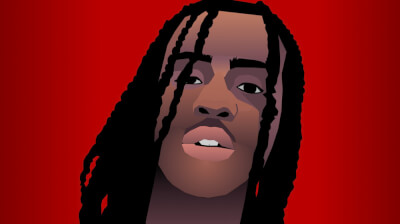Chicago rapper Chief Keef, also known by his given name Keith Farrelle Cozart, has released seven full-length projects this year. Some tapes reveal updated or recycled versions of unofficially released songs previously unavailable for streaming. Greek billionaire Alki David’s handling of Keef’s career leaves fans to guess if these projects are simple data-dumps manufactured to capitalize on the streaming era or albums stocked with new curated material. Just last month, David boasted about the popularity of Keef’s mini-hit “Soldier” in a bizarre interview. The original version of “Soldier” sounds nothing like the demonic EDM mutation dedicated fans have been subjected to, and it begs the question of just how much control Keef has over his output.
When you narrow in on the all-new and original material, a clearer picture of the 23-year-old veteran emerges. Despite reorienting the entire landscape and style of modern rap when he was 16 years old, many casual fans and critics have locked into the idea that Keef is a fad of the past. He operates outside of the centralized industry that deems his art morally uncertain and socially reprehensible. While other great rappers settle into a comfortable middle ground and resist testing uncharted stylistic territory, Chief Keef continues to stay hungry, intense and refreshingly authentic.
One of Keef’s first songs, titled “Dead and Gone,” was recorded in 2010 when he was just 15 years old. The track is an ode to his friends Keta and Bebe, who were killed in his Chicago neighborhood. Keef’s emotional maturity was on full display as he rapped, “Everybody dying it’s starting to be my issue, now Keta in the sky she seeing white like some tissue.” Two years and a handful of menacing mixtapes later, Keef released his debut album, “Finally Rich,” under Interscope records. His single, “Love Sosa,” climbed to number 10 on the rap charts and he joined Justin Bieber as America’s new teen sensation. Hip-hop purists and local government officials united against Keef on account of his lyrics and videos. In 2013, he bragged that his upcoming mixtape, “Bang 3,” was so powerful it would raise the city’s murder rate. At the time of this statement, Chicago had already recorded 373 murders since the year began. While he rarely touched on the systematic issues that left his neighborhood in such a state, his vision always swiveled across the dangers of street life.
Gangster rap has been a scapegoat of media members and lawmakers since Philadelphia rapper Schoolly D invented the style in 1985. Black Entertainment Television (BET) banned Keef from performing on their network. Former host of the BET’s show, “106 and Park,” Shad Moss, also known by his stage name Bow Wow, confirmed that the network banned Keef in 2016. Although “106 and Park” was established to project black artists, they exercised gatekeeping techniques and took aim at the entire Drill scene, Chicago’s iteration of trap music that is bubbling out of the city’s struggling neighborhoods. The general competition among artists coupled with local conflicts is intertwined with the death of several young rappers. Yet, Drill still hinged on allowing artists to express themselves through music and a shared local language.
It is impossible to truly quantify cultural influence, and this is what made Keef such an easy target for the Chicago police department. Despite never being accused of murder, he was demonized in order to provide a simple answer to the complicated problem of gang violence. He currently lives in Los Angeles after being exiled from Chicago’s city lines due to arrest warrants detailing unpaid child support and absence from a pretrial hearing. In 2015, he attempted to play in Chicago via hologram for a Stop the Killing Now Hologram Benefit Concert. After getting through one song, police shut down the event. Outlawing his physical presence wasn’t enough of a precaution. Keef’s image was dehumanized because the state feared it invoked sacrilegious symbols. He was beamed in from a different time zone, but his three-dimensional image still disturbed local law enforcement. This misguided decision worked to suppress the achievements of an artist who lifted his family out of poverty when he was 16 years old. His music unified a community of young fans in a city that felt the effects of violent conflict. Chicago got its first national superstar since Kanye West came on the scene in 2004. Keef became the voice of his generation and put his hometown back on the map, yet he can’t set foot in it.
“Cozart’s music promotes violence and posed a significant public safety risk,” a spokeswoman for Mayor Emanual told the Chicago Tribune.
Keef’s newest record, “Back From The Dead 3,” completes the trilogy and joins “Mansion Muzik” and “Ottopsy” as his best projects of the year. The first edition of “Back To The Dead” included his single “I Don’t Like,” which has amassed 32 million views on Youtube since 2012. Public sentiment would suggest his ferocity has withered, but the records tell a different story. His 2013 and 2014 material is more radical, but Keef maintains his hardened attitude despite a stylistic shift. On “Back From The Dead 3,” he balances his left field use of auto-tune with new and dynamic flows. By interpolating bits and pieces of language and cadence from other regions, Keef creates a new model of the genre in his own image. His lyrics remain imaginative with playful word choices and intoxicating images of success. Squeezed between promises and observations are lines like, “Last night I had a dream that the sky went away.” The record’s last track, “Pharrell,” never breaks form as a looped piano spins a tight web around Keef’s claustrophobic cadence. His nonchalance makes mastery sound simple.
![]()



































